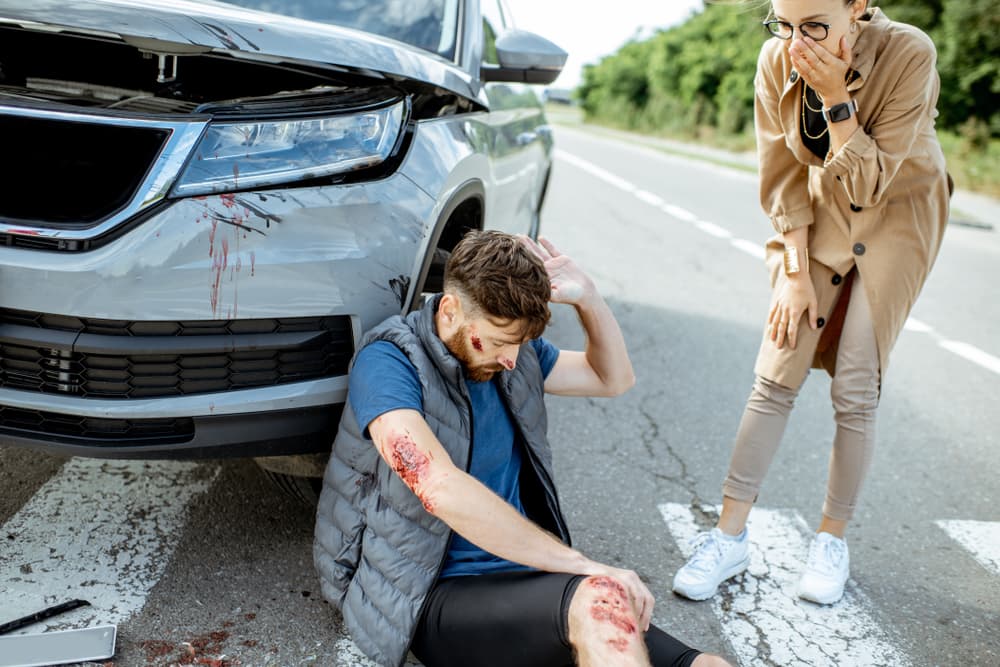Drivers are required to watch for pedestrians and yield to them when crossing the road. However, drivers these days are in a hurry and often inattentive, leading to far too many pedestrian accidents. Every year, approximately 60,000 pedestrians are hurt, and 4,000 are killed in these accidents.
If you are hurt in a pedestrian accident, you might have some of the severe injuries mentioned in this article. When you are dealing with injuries and losses after a pedestrian collision, you’ll need to understand what your legal options are for compensation. Keep reading to learn more, and contact an experienced pedestrian accident attorney in your area to discuss a possible case today.
Most Common Pedestrian Accident Injuries
When a car slams into a pedestrian, serious injuries are almost unavoidable. Between the vehicle hitting the person and the pedestrian hitting the ground, the injuries can be catastrophic to the following body regions:
Lower Extremities
When the vehicle hits a person, the lower extremities are often the first to be struck. Approximately 50 percent of pedestrian accident victims have severe injuries to the lower parts of the body, including broken bones, torn muscles and ligaments, pelvic fractures, and serious lacerations and road rash.
Face, Head, And Neck
The neck, face, and head are also often damaged in a pedestrian accident. This can happen when the neck, face, or head slams into the hood, windshield, and ground. About 40 percent of pedestrians have neck, face, and head injuries. Common examples of serious injuries are shoulder dislocations, spine injuries, neck injuries, skull fractures, jaw fractures, concussions, and lacerations.
Upper Body
The upper extremities are often struck in these accidents when the pedestrian lands on the car’s hood or if they are thrown over the vehicle. About 30 percent of injuries in pedestrian accidents involve the upper body. Many musculoskeletal injuries can happen in the wrists, arms, and hands. There also may be severe impacts to the chest or abdominal area.
Pedestrians may be up to twice as likely to suffer a head injury than one to the chest or head. Any serious impact on this part of the body can result in a severe or fatal injury.
Regardless of your injuries (or lack thereof) after a pedestrian accident, always be looked over at the ER after the incident. You may be unaware of the severity of your injuries at first. Delaying medical care can risk your health and the possibility of getting compensation in a personal injury claim.
Damages In a Pedestrian Accident Claim

Many pedestrians suffer severe, life-changing injuries after an accident. Usually, a pedestrian accident claim ends in an insurance settlement, but a court case is possible if the insurance company refuses to offer enough money for your losses.
Losses in a pedestrian accident case tend to be extensive, often leading to contentious matters. Most pedestrian accident claims involve the following types of compensation:
- Payment for current and future medical bills. Your attorney may not start serious settlement negotiations until you have reached maximum medical improvement and your prognosis is clear.
- Pain and suffering. You can receive compensation for mental and physical pain and suffering. This is subjective, and your attorney will argue strongly for the most payment for your pain and suffering.
- Lost earnings. You can be out of work for months and may be entitled to back pay. You can also receive compensation for the loss of ability to earn a living if you are partially or permanently disabled.
Your attorney will have to prove that the at-fault party caused the accident, and as a consequence, you suffered the damages mentioned above. If your attorney can prove that the driver or other party caused the accident, you can receive a settlement for your losses. Most insurance companies won’t risk going to trial in a personal injury lawsuit if fault for the accident is clear.
Legal Options After A Pedestrian Accident
The fastest way to get compensation for medical bills and other damages after a pedestrian accident is to file an insurance claim. You can file a personal injury lawsuit if the insurance company doesn’t offer a fair settlement. Legal options after a pedestrian accident are:
File A Claim Against The Driver
If you are hit by a car, the driver is usually at fault, but not always. Even if you were not in a crosswalk when struck, the driver can still be responsible. The reason is that most states require all drivers to watch for pedestrians and take reasonable actions to avoid hitting them.
The accident is almost always the driver’s fault if the vehicle hits you in a crosswalk. Even a pedestrian struck outside a crosswalk can win a personal injury claim if they prove the driver was distracted or not paying attention.
The driver’s insurance company will pay for your losses in a pedestrian accident in many accidents. In many cases, the fault will be clear. For instance, when a speeding driver strikes you in a crosswalk, the driver’s insurance company will almost certainly accept liability to avoid an expensive lawsuit. The insurance company will likely offer a settlement to avoid litigation. However, you may need a pedestrian accident attorney to maximize your compensation.
Make A Claim Against The Government
Many pedestrian accidents are caused by other drivers. However, some accidents happen because of problems with road design or traffic control devices, such as stop signs or traffic lights.
For instance, you can be hit by a car in a crosswalk if the traffic light at the intersection is broken. In this case, you can file a claim against the local government or agency responsible for maintaining the traffic signal.
Another possibility is if the local government placed the crosswalk in an improper place. There can be a crosswalk placed right after a major curve in the road, and there are no warning signs for drivers alerting them to the crosswalk. This is a poor road design and a safety hazard. Drivers can come around the curve at high speed, unaware of a crosswalk ahead.
How Do I Prove Liability In A Pedestrian Accident Lawsuit?

Receiving fair compensation after a pedestrian accident is vital to your recovery. But it isn’t enough to claim that a driver hit and injured you; it must be proven to the insurance company or jury. Proving fault means showing that another party’s negligence caused the accident and your injuries. The negligence doctrine states that you must prove the following to be entitled to damages:
- Duty: All drivers have a duty of care to drive safely, avoid accidents, obey the law, and not injure others. This duty includes watching for pedestrians and pedestrians crossing the street outside crosswalks.
- Breach: A driver breaches their duty of care if they violate the law somehow and hit another person. For example, perhaps the driver ignored a red light and was speeding when they hit you in a crosswalk.
- Cause: The breach of the duty of care must have caused you damages, such as head trauma and a broken leg in the accident.
- Damages: You have physical injuries and financial damages. For instance, you probably have medical bills and lost income.
A skilled pedestrian accident attorney must prove these four aspects of negligence in a pedestrian accident claim. Trying to do this alone might sound easy when the accident’s fault is clear. However, insurance companies know how to avoid paying claims if they can, and you will need to prove your case conclusively to receive damages. Pedestrian accidents usually have serious injuries, so it is usually best to allow a skilled pedestrian accident lawyer to handle the case for you.
Who Covers Your Medical Bills After A Pedestrian Accident?
The aftermath of a pedestrian accident will be scary and confusing. You will probably have serious injuries, such as broken bones and cuts and bruises. You will likely wonder how your injuries will be treated and who will pay for them. In most states, the at-fault party is responsible for paying for the injured person’s medical bills and other damages. Some of the parties who can be responsible for paying your damages are:
- The driver who caused the accident. Usually, the at-fault driver’s insurance company will be responsible for paying for your damages. If your damages exceed the person’s insurance coverage, it is possible to file a personal injury lawsuit against the person to collect the rest if they have significant assets.
- The vehicle owner involved in the pedestrian accident if they are different from the person who hit you.
- The employer of the driver if the driver was working at the time of the accident. For instance, if the driver is employed by FedEx and hit you in a crosswalk during work hours, FedEx can be liable for your injuries.
- Your own auto and health insurance. Your Personal Injury Protection (PIP) insurance can pick up your initial medical bills and lost income in a no-fault state. You can file a lawsuit against the at-fault driver if your damages exceed that coverage. If your health insurance pays for your initial medical bills, it may seek reimbursement from the at-fault party’s insurance company.
What Is My Pedestrian Accident Claim Worth?

Many injured parties want to know how much they can receive for damages from their pedestrian accident. There are too many variables in these accidents to generally say what a fair settlement can look like. Some pedestrian accidents involve more severe injuries than others and can be worth more. Generally, the value of a pedestrian accident claim depends on the following variables:
- How clear it is that the driver was at fault. If the driver was entirely at fault, this usually results in more compensation than if the fault picture is cloudier.
- How severe your injuries are. Someone with head trauma and a spinal cord injury will receive more in a pedestrian accident claim than a person with a broken arm. The amount of compensation will also rise if the injuries are long-term or permanent. You can require extensive medical care for years or even for life.
- How much the injuries affect your life and ability to earn a living. The claim will be worth more if you can no longer work or care for yourself.
- The pain and suffering you have from your accident injuries and treatments. You can receive significant compensation for mental and physical pain and suffering from a pedestrian accident claim.
Remember that most personal injury claims end in a settlement, and the insurer might not initially offer the full monetary value of the claim. Your pedestrian accident lawyer might need to negotiate with adjusters for a higher offer. They might need to file a lawsuit to seek the full amount you deserve.
But going to court is a risk and takes time. Whether to accept a settlement or pursue litigation is a decision you will carefully weigh with your pedestrian accident lawyer. Your attorney will play a vital role in ensuring you get the most compensation in your settlement or award.
How Long Do I Have To File A Pedestrian Accident Lawsuit?
If you suffered an injury in a pedestrian accident, you may have the right to receive damages, but you only have so much time to file your claim. Every state has a statute of limitations that sets a time limit on how long you have to file a personal injury claim. Most states give you two or three years from the date of the injury to file a claim. However, some states only allow a year. Make certain you know the statute of limitations in your state. If you aren’t sure, speak to a personal injury attorney today. If you miss the deadline, you will lose the right to receive compensation, so take action today.
Speak To A Pedestrian Accident Attorney Today

Were you hit by a car recently? Do you have severe injuries and are unable to work? You can be entitled to compensation in a pedestrian accident lawsuit. Have an experienced personal injury attorney review your case at no charge. If your case has merit, you can receive a settlement to pay for your medical bills, lost earnings, and pain and suffering. Contact a pedestrian accident attorney today!